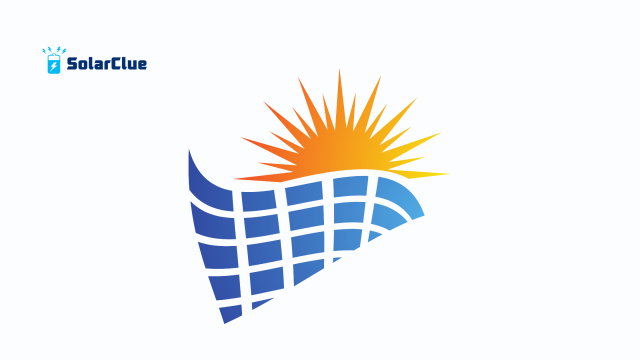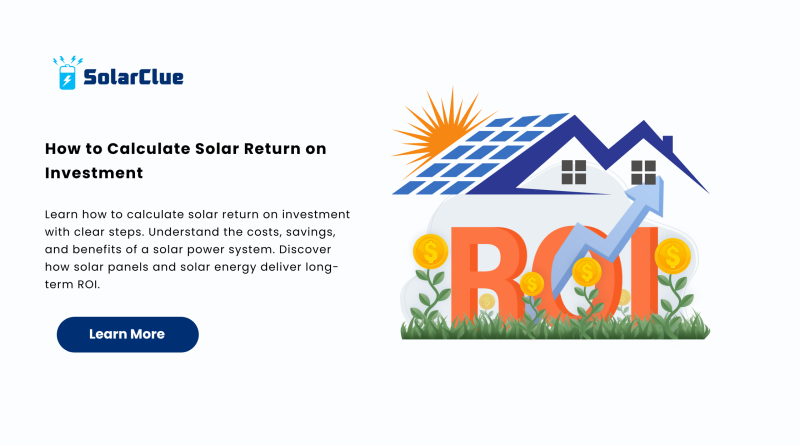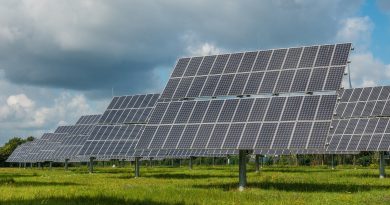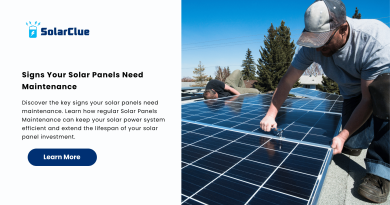How to Calculate Solar Return on Investment
Investing in a solar power system is not just about going green—it’s also about saving money and making a smart financial choice. One of the most common questions homeowners and businesses ask before making the switch is: How do I calculate the solar return on investment (ROI)? The answer lies in understanding the balance between the upfront cost of a solar panel installation and the long-term savings generated through reduced electricity bills, government incentives, and increased property value. In this blog, you’ll learn everything about ROI in solar energy, with simple methods, examples, and tips to maximize your savings.
Table of Contents
What is Solar Return on Investment?
Return on Investment (ROI) is the percentage that measures the profitability of your investment. In the case of solar power, ROI tells you how quickly your system pays for itself and how much profit it generates afterward. A higher ROI means faster payback and greater financial benefits over the system’s lifetime.
Factors Influencing Solar ROI
1. Initial Cost of Solar Installation
The upfront cost of a solar power system includes purchasing solar panels, inverters, mounting equipment, and installation charges. Prices vary depending on the size of the system, the type of solar panel, and whether the system is grid-tied, hybrid, or off-grid.
2. Government Incentives and Subsidies
Many governments provide subsidies, tax credits, and incentives to promote solar energy adoption. These reduce the net cost significantly and improve ROI.
3. Electricity Tariffs and Savings
The higher your local electricity tariff, the greater your savings with solar power. A properly sized solar power system can cut down monthly electricity bills by up to 80–90%.
4. System Efficiency and Maintenance
The performance of your solar panel system depends on quality, efficiency, and regular maintenance. Panels with higher efficiency may cost more upfront but yield better ROI in the long run.
5. Net Metering Benefits
If your region offers net metering, you can sell excess solar energy back to the grid. This adds another revenue stream, boosting ROI.
6. Lifespan of Solar Panels
Most solar panels have a lifespan of 25–30 years. The longer your system lasts with consistent performance, the higher your return.
How to Calculate Solar ROI Step by Step
Step 1: Determine the Total System Cost
Include the price of solar panels, inverters, wiring, installation, permits, and other charges. For example, if your 5kW system costs ₹3,00,000 after subsidies, this is your initial investment.
Step 2: Estimate Annual Savings
Calculate how much you’ll save annually on electricity bills. If your electricity bill is ₹5,000 per month and your system covers 80%, your yearly savings would be ₹48,000.
Step 3: Add Net Metering and Incentive Benefits
If you earn ₹10,000 annually from selling extra electricity back to the grid, add this to your savings, making the total annual benefit ₹58,000.
Step 4: Use the ROI Formula
ROI (%) = (Annual Savings ÷ Total Cost) × 100
For the above example: ROI = (58,000 ÷ 3,00,000) × 100 = 19.3%
Step 5: Calculate Payback Period
Payback period = Total Cost ÷ Annual Savings
Here, ₹3,00,000 ÷ ₹58,000 = 5.17 years. This means you will recover your investment in just over 5 years.
Example of Solar ROI for a Homeowner
Let’s assume a homeowner installs a 7kW solar power system for ₹4,20,000.
-
Monthly bill before solar: ₹7,000
-
Solar covers 85% of bill → Monthly savings: ₹5,950
-
Annual savings: ₹71,400
-
ROI = (71,400 ÷ 4,20,000) × 100 = 17%
-
Payback period = 4,20,000 ÷ 71,400 ≈ 5.9 years
After 6 years, the system pays for itself. For the remaining 20+ years, the homeowner enjoys free solar energy savings, which could total more than ₹15 lakh.

Benefits of Calculating Solar ROI
Financial Clarity
Knowing your ROI helps you make an informed decision and understand when you’ll start profiting from your solar panel system.
Smart Investment
Comparing ROI with other investments like fixed deposits or stocks helps homeowners and businesses see why solar energy is a stable, risk-free option.
Long-Term Planning
By understanding ROI, you can plan finances, predict savings, and allocate funds for other projects.
Tips to Maximize Solar ROI
-
Choose high-quality solar panels with higher efficiency and longer warranties.
-
Opt for a professional installer to ensure optimal placement and system performance.
-
Regularly clean and maintain your solar power system to avoid efficiency losses.
-
Explore government subsidies and tax benefits to reduce upfront costs.
-
Monitor your system’s performance with tracking apps and meters.
Common Mistakes While Calculating ROI
-
Ignoring maintenance costs and potential inverter replacement.
-
Not factoring in electricity tariff hikes (which actually make savings larger over time).
-
Overestimating sunlight hours without considering shading or weather patterns.
-
Forgetting to include government incentives in ROI calculations.
FAQs on Solar ROI
1. How do I know if solar is worth the investment?
If your electricity bills are high and you have good access to sunlight, a solar power system will likely give you a strong ROI.
2. What is the average payback period for solar panels?
Most homeowners recover their investment within 5–7 years, depending on system size, electricity costs, and government incentives.
3. Do solar panels increase home value?
Yes, homes with solar panels often sell faster and at higher prices because buyers value lower energy bills.
4. Is ROI higher for residential or commercial solar systems?
Commercial systems often enjoy higher ROI because of larger installations, bulk savings, and higher electricity usage.
5. Can ROI be negative?
Only if the system is poorly designed, installed incorrectly, or heavily shaded. With proper planning, ROI is almost always positive.
Conclusion
Understanding how to calculate solar return on investment is crucial for anyone considering a switch to solar energy. By evaluating costs, savings, and long-term benefits, you can see how quickly a solar power system pays for itself and how much financial freedom it offers. A smart investment in solar panels not only reduces bills but also ensures a cleaner, greener future. To dive deeper into smart solar solutions, visit solarclue.com and blog.solarclue.com today—your journey towards sustainable savings starts here!



